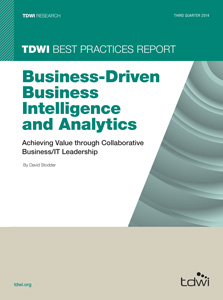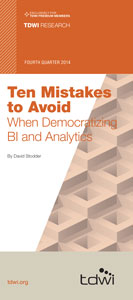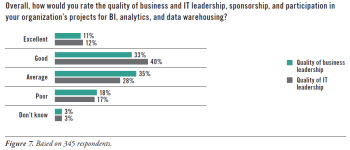 View online: tdwi.org/flashpoint
View online: tdwi.org/flashpoint





January 15, 2015
ANNOUNCEMENTS
NEW TDWI Best Practices Report
Next-Generation Analytics and Platforms
NEW TDWI Checklist Report
Self-Service Big Data Exploration Best Practices
NEW TDWI E-Book
A Guide to Hadoop for Data Warehousing and Operational Analytics
CONTENTS

Revisiting Enterprise Information Portals to Alleviate BI and Analytics Complexity

The Intersection of BI and Revenue Management

Improving Business/IT Leadership and Collaboration

Mistake: Not Knowing Enough about the Data

See what's
current in TDWI Education, Events, Webinars,
and Marketplace

Revisiting Enterprise Information Portals to Alleviate BI and Analytics Complexity
Richard Hines
Hitachi Solutions
As we all know, the current state of the business user experience for accessing and analyzing information could be vastly improved. Most organizations have a large number of transactional applications, more than one integrated data repository, and several flavors of reporting and BI tools. It is not surprising that our business colleagues are sometimes confused and frustrated that they can’t answer basic questions and are uncertain about where to find the right data for a specific subject area.
What happened? In the beginning, we aimed to create a single version of the truth and implement a standardized platform so information workers would be well served with high-quality, timely information for decision making and performance management. Well, that dream is over. The simple fact is that the BI landscape has evolved and is now more convoluted than ever.
How have things become more complicated? Over the last several years, our BI environments have become increasingly complex:
- Transactional applications with BI capabilities: These days, when you buy an application, it is often bundled with BI-like capabilities. Taking it a step further, if you recently purchased an ERP solution, you have probably also been informed that you now own an enterprise BI platform. Although this trend is cause for much debate, the impact is that we typically end up with federated BI capabilities across the organization.
- Specialized BI/analytics applications: There are many instances in which niche BI/analytics applications are quite effective in delivering specialized analytics workloads—for example, mining safety analytics applications or predictive maintenance applications. The result is that there may be silos of analytics applications across technology environments.
- Operational data repositories: In some cases, specialized operational workloads require an integrated data repository. However, they are extremely large and complex in their own right, so they might create an undue imbalance in the enterprise data repository—for example, a call center data mart or an operational data mart for machine sensor data.
- Big data repositories: With more widely established competency in leveraging unstructured data, we now have another new data repository that may be vast and complex. In addition, we may outsource some of this capability or establish more than one big data repository.
The cumulative effect of these, as well as other technology developments, is that our business colleagues sometimes struggle with the questions: “What information? Where?”
Revisiting Enterprise Information Portals Can Help
An enterprise information portal can obfuscate the complexity of our multiple BI technology environments by acting as a single gateway for the business to access information, regardless of which source provided that information. In most cases, business people should not care whether they acquire information from a transactional application, data mart, data warehouse, or in-memory appliance. Instead, they should be focused on procuring trusted information to guide profitable decision making.
Given these federated data/BI architecture issues, this is clearly not a trivial undertaking. It takes significant effort to map systems of record for data subjects and information context. In addition, there can be a complex security model to control access to multiple data source applications. As one COO put it, “If we have to increase technical complexity to simplify access to data, I’m okay with that.” Naturally, there will be boundaries for how much complexity to take on, but this is a reasonable guiding principle.
Getting Started
Enterprise information portals have experienced some success providing streamlined document management in the enterprise, but they are not typically playing a large role in BI and analytics. Ultimately, great information portals are all about information taxonomy. Although this is a large topic, for our purposes we can say that taxonomy is focused on usage patterns and information flow to guide the user experience for information navigation and classification. This is a significant undertaking that requires long-term vision and patience because it is common to get distracted along the way. The following steps will help:
- Start small with a specific department or BI initiative
- Identify and categorize information subjects and information context by department or role
- Develop a hierarchy for how the business would like to navigate information
- Create a mapping of information subjects to existing BI and transactional application assets
- Surface the appropriate report/dashboard/analytical application from the underlying best-fit BI or application asset
When we use the enterprise information portal, we should achieve many benefits, which will include:
- Simplifying access to information
- Maximizing the value of technology investments by leveraging all reporting and BI capabilities across transactional application repositories and BI data repositories
- Potentially integrating less data to the data warehouse because the source application reporting or dashboard may be adequate for information needs
Again, enterprise information portals can also assist with document management, records management, and information workflows, but that is conversation for another day.
Richard Hines is the global vice president of analytics for Hitachi Solutions.

The Intersection of BI and Revenue Management
Hugh J. Watson with Jon A. Higbie
If you have been in analytics for a while, you know that revenue management is an old, well-established practice in some industries. Its primary goal is to sell the right product to the right customer at the right time for the right price. Revenue management combines forecasts, predictions of customer behavior, inventory data, price sensitivity, competitive data (e.g., prices), and analytics to optimize revenues and profits from the sale of products and services.
Revenue management is commonly used to price perishable goods such as airline seats, rental cars, and hotel rooms. After a recent conversation with a long-time friend, Jon Higbie, who is a partner and chief scientist at Revenue Analytics, I realized that much has taken place in the field that people in BI and analytics should know about. I asked Jon to collaborate with me to briefly describe how revenue analytics typically works, describe recent developments and trends, and explain why BI and analytics professionals should be interested in the topic.
Learn more: Read this article by downloading the Business Intelligence Journal, Vol. 19, No. 4



Highlight of key findings from TDWI's wide variety of research
Improving Business/IT Leadership and Collaboration
Success with business-driven BI and analytics projects involves more than allocating budgets and choosing technologies. It requires leadership from both business and IT management. We asked research participants to rate the overall quality of business and IT leadership, sponsorship, and participation in their organizations’ projects for BI, analytics, and data warehousing (see Figure 7). IT leadership came out ahead of business leadership; just over half (52%) of research participants regard their IT leadership positively, with participants choosing either good (40%) or excellent (12%). Less than half (44%) of participants regard their business leadership of BI, analytics, and data warehousing projects positively; 33% said it was good and 11% said it was excellent.
The findings suggest that both business and IT leaders should improve. A top priority for business side leadership is to articulate the vision for how the project will create business value and to provide steady guidance as the project moves toward that vision. IT leadership needs to make sure the vision is supported by the project’s development and management; IT must understand the project’s risk, see where it could run into obstacles, and take steps to sustain a troubled project before it’s too late. If “democratization,” or the deployment of BI and analytics tools, dashboards, or applications across the enterprise is the goal, IT must assemble scalable technologies, practices, and training to support a large number and variety of users.
Read the full report: Download Business-Driven BI and Analytics (Q3 2014)



FlashPoint Rx prescribes a "Mistake to Avoid" for business intelligence and data warehousing professionals.
Mistake: Not Knowing Enough about the Data
David Stodder
BI and analytics are nothing without good data. For democratization initiatives to succeed, it is as important to get to know the data as the users and what they plan to do with it. In many organizations, the speed data is growing is outpacing IT’s knowledge of the data. Too many organizations neglect this task, making data chaos a barrier to success. BI and analytics projects grind to a halt because users are uncertain about data’s quality and completeness.
To support democratization, organizations must implement more consistent and automated methods (such as profiling and data discovery) to increase their knowledge of the data and how data elements are related within and across sources. Certainly, regulatory requirements have been driving organizations to know more about their data so they can respond to audits and protect sensitive data. Now, BI and analytics are becoming drivers; by applying consistent methods and software tools where possible to learn about the data, organizations can save information management costs and increase user satisfaction.
The most common obstacle to realizing higher value from data is that organizations are faced with disconnected data silos and cannot easily bridge them to provide users with a single view of integrated data sources. Thus, the first step in establishing a single view is with “data discovery” to find out what data is located where and how it is currently being used. You can discover and document how data elements and their attributes are related within and across data stores, which is critical to building the single view. You should discover and document all extraction, transformation, and loading (ETL) operations; this step helps you weed out unnecessary or unauthorized ETL routines. All of this knowledge should be documented in a metadata repository, business glossary, or similar knowledge-capture system.
Read the full issue: Download Ten Mistakes to Avoid When Democratizing BI and Analytics (Q4 2014)




